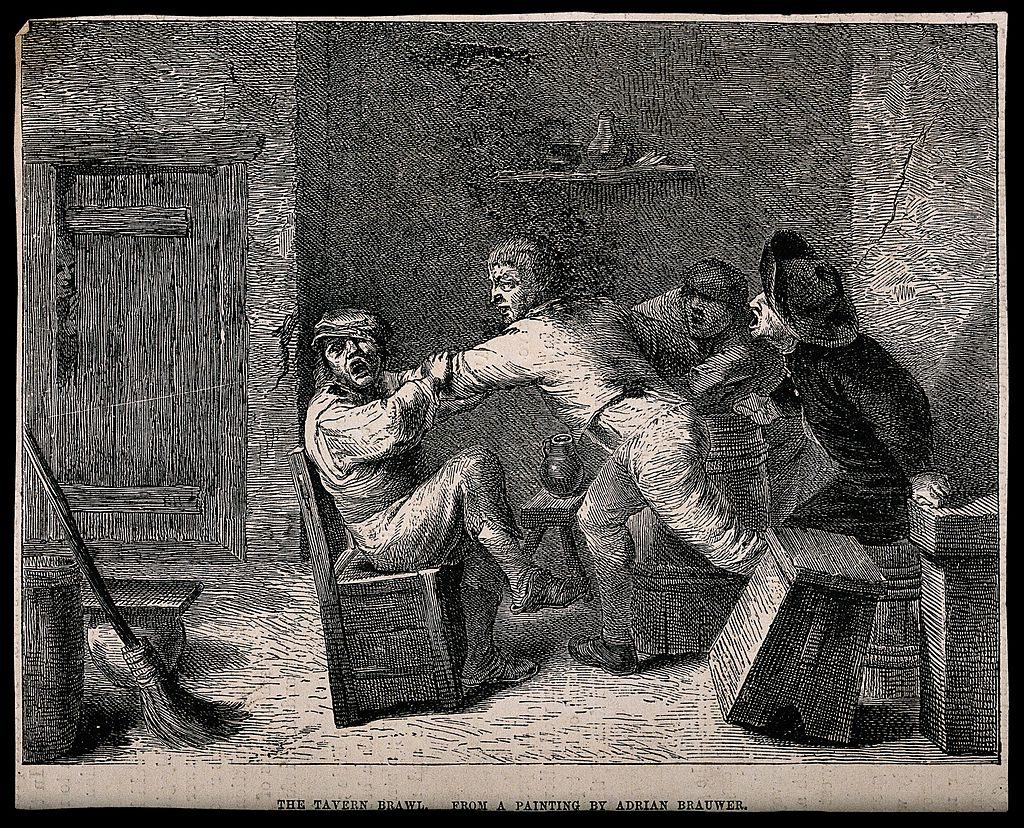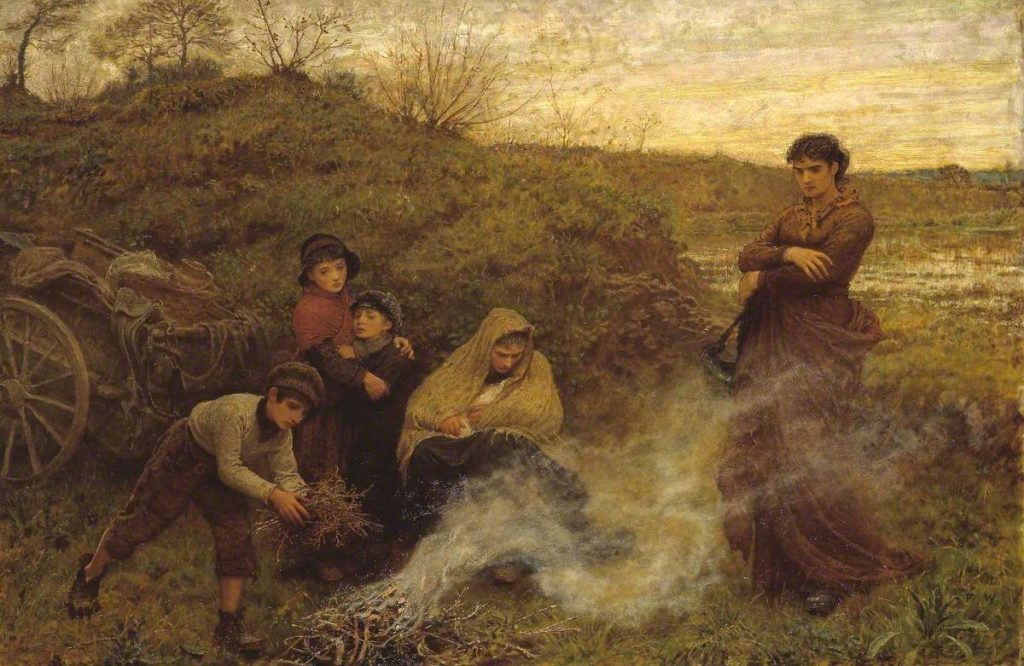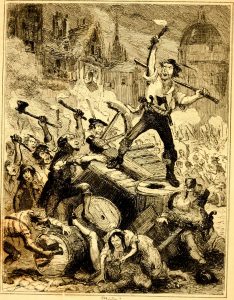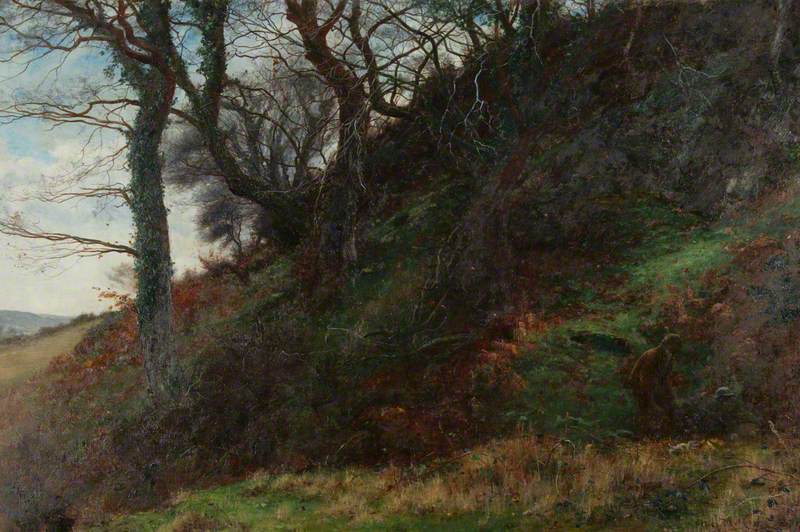This is the second in our series of posts on crime and punishment in 18th-19th century Scotland. This time we are looking at what the parish reporters thought were the causes of crime, as well as what measures were being put in place help prevent crime. There are some very interesting opinions on both these subjects found in the Statistical Accounts.
Reasons for crime
It is not surprising to read that crime was mostly attributed to alcohol, or, more specifically, drunkenness! There are some very damning views shared in the parish reports. The Rev. Mr Thomas Martin wrote in the parish report for Langholm, County of Dumfries, “let the distilleries then, those contaminating fountains, from whence such poisonous streams issue, be, if not wholly, at least in a great measure, prohibited; annihilate unlicensed tippling-houses and dram-shops, those haunts of vice, those seminaries of wickedness, where the young of both sexes are early seduced from the paths of innocence and virtue, and from whence they may too often date their dreadful doom, when, instead of”running the fair career of life” with credit to themselves, and advantage to society, they are immolated on the altar of public justice.” (OSA, Vol. XIII, 1794, p. 605)
In Tinwald and Trailflat, County of Dumfries, it was reported that “there are at present 2 small dram-shops in the parish which we have the prospect of soon getting rid of. They have the worst possible effect upon the morals of the people: and there is scarcely a crime brought before a court that has not originated in, or been somehow connected with, one of these nests of iniquity.” (NSA, Vol. IV, 1845, p. 50)

‘A drunken brawl in a tavern with men shouting encouragement’, 19th century wood engraving after A. Brouwer. [Wellcome Images, [CC BY 4.0 license (https://creativecommons.org/licenses/by/4.0)], via Wikimedia Commons]
In Stirling, County of Stirling, “there are 96 of these [inns, ale-houses, etc], of different degrees of respectability in the parish ; of which 91 are in the town, and 5 in the villages of Raploch and Abbey.” Two interesting points were also made here: that owners of houses received higher rents if their buildings became ale-houses and that “the number of charitable institutions on which so large a portion of the people have a claim” had a negative impact, as they trained “them to a species of pauperism”. (NSA, Vol. VIII, 1845, p. 448).
The cheap cost of alcohol, as well as the number of ale-houses in existence, was believed to be a factor in the higher level of crime. In the parish of Orwell, County of Kinross, “in consequence of the low price of spirits within these last six or eight years, there have been more petty crime and drunkenness than was formerly known.” (NSA, Vol. IX, 1845, p. 66)
It is fascinating to read the parish report from Hutton and Corrie, County of Dumfries, which states that “in 1834, the House of Commons appointed a Select Committee of their number to take evidence on the vice of drunkenness. The witnesses ascribe a large proportion, much more than the half of the poverty, disease, and misery of the kingdom, to this vice. Nine-tenths of the crimes committed are considered by them as originating in drunkenness… The pecuniary loss to the nation from this vice, on viewing the subject in all its bearings, is estimated by the committee, in their report to the House of Commons, as little short of fifty millions per annum. ” (NSA, Vol. IV, 1845, p. 550)
In the parish of Corstorphine, County of Edinburgh, “the persons there employed are collected from all the manufacturing towns in England, Ireland, and Scotland. They are continually fluctuating; feel no degree of interest in the prosperity of the place; and act as if delivered from all the restraints of decency and decorum. In general, they manifest a total disregard to character, and indulge in every vice which opportunity enables them to perform” and is further noted that “the influence of their contagious example must spread” to others in the parish. (OSA, Vol. XIV, 1795, p. 461)
- Lack of religious upbringing and instruction
In some corners, crime was also attributed to a lack of religious upbringing and instruction. As mentioned above, there was a report made to the House of Commons on drunkenness and its affect on crime. “In London, Manchester, Liverpool, Dublin, Glasgow, and all the large towns through the kingdom, the Sabbath, instead of being set apart to the service of God, is made by hundreds of thousands a high festival of dissipation, rioting, and profligacy.” (NSA, Vol. IV, 1845, p. 550)
Govan, County of Lanark, was seen as a district “where there is no civil magistrate to enforce subordination, and to punish crimes, what can be expected, but that the children should have been neglected in their education; that many of the youth should be unacquainted with the principles of religion, and dissolute in their morals; and that licentious cabal should too often usurp the place of peaceable and sober deportment.” (OSA, Vol. XIV, 1795, p. 295) It was also noted that “if neighbouring justices were, at stated intervals, to hold regular courts in so large villages, they might essentially promote the best interests of their country. They would be a terror to evil doers, and a protection to all that do well.”
In the parish report for Ardrossan, County of Ayrshire, it was remarked that “we have certainly too many among us who have cast off all fear of God, and yield themselves up to the practice of wickedness in some of its most degrading forms, yet the people in general are sober and industrious, and distinguished for a regard to religion and its ordinances. Not only is the form of godliness kept up, but its power appears to be felt, by not a few among them maintaining a conversation becoming the gospel.” (NSA, Vol. V, 1845, p. 199)
Crime prevention
So, according to the parishes throughout Scotland, how best could crimes be prevented? As the parish report of Langholm, County of Dumfries, mentions, “it is much more congenial to the feelings of every humane and benevolent magistrate to prevent crimes by all possible means, than to punish them… Remove the cause, and the effects in time will cease.” (OSA, Vol. XIII, 1794, p. 605) In the parish report of North Knapdale, County of Argyle, correcting criminal behaviour is preferable to punishment. “Such evil consequences can never be prevented without knowledge and education; and for this reason men, in power and authority, should pay particular attention to the subject.” (OSA, Vol. VI, 1793, p. 265)
In some quarters, punishments were considered too lenient. In the parish of Fetlar and North Yell, County of Shetland, “the punishments inflicted for such crime of theft, in particular, are so extremely mild, that they rather excite to the commission of the crime than deter from it.” (OSA, Vol. XIII, 1794, p. 285) In some parishes trouble-makers and criminals were simply expelled from that city, town or parish, instead of being punished! As pointed out in the parish report of Muirkirk, County of Ayrshire, “this is neither more nor less, than to punish the adjacent country for sins committed in the town, to lay it under contribution for the convenience of the city, and free the one of nuisances by sending them to the other.” (OSA, Vol. VII, 1793, p. 609) (Although in the parish of Killin, County of Perth, “the turbulent and irregular [were] expelled the country to which they were so much attached, that it was reckoned no small punishment by them.” (OSA, Vol. XVII, 1796, p. 384))
In Liberton, County of Edinburgh, it was felt that “nothing can remove the evil of assessments now, (which would be ten times greater, but for the efforts of the kirk-session,) but the subdivision of parishes, the diffusion of sound instruction and Christian principle amongst the people, and the removal of whisky-shops. Crime, drunkenness and poverty are always found together, and expending money upon the poor, except for the purpose of making them better, will as soon cure the evil as pouring oil upon a flame will quench it.” (NSA, Vol. I, 1845, p. 27)
In the parish reports there is no lack of suggestions on how to deter crime and punish criminals.
– Restrictions on selling alcohol
A very interesting suggestion was made in the parish report for Callander, County of Perth in November 1837. ” Considerable improvement has taken place within these few years in the management of the police of the country; yet there are many crimes allowed to pass with impunity. Would it not tend much to diminish crime if there were fewer licenses granted for selling, spirits, and more attention paid to the character of the persons to whom licenses are given?” (NSA, Vol. X, 1845, p. 360) A similar observation is made in the report for the parish of Stirling, County of Stirling, where “granting of licenses, without sufficient inquiry as to the character of the applicant” is believed to be one of the reasons for crime. (NSA, Vol. VIII, 1845, p. 448)
In the report made to the House of Commons on drunkenness and its affect on crime “a great many of the witnesses recommended the prohibition of distillation, as well as of the importation of spirits into the kingdom.” The report also stated that religious institutions had a big part to play in “rooting out drunkenness, now appearing in every part of the kingdom”. (NSA, Vol. IV, 1845, p. 550)
In Kennoway, County of Fife, “the grand remedy, if it could be applied, would be to lay a restriction on the improper use of ardent spirits. Drunkenness is certainly the prevailing vice amongst us ; and is the originator, or at least inciting cause, to almost every mischief. Imprisonment for violent assault under its influence has of late been in two instances inflicted.” (NSA, Vol. IX, 1845, p. 381)
– Law enforcement and confinement
In the parish of Gargunnock, County of Stirling, a problem with vagrants is reported. “They spend everything they receive at the first ale-house; and for the rest of the day they become a public nuisance. The constables are called, who see them out of the parish; but this does not operate as a punishment, while they are still at liberty. It would be of great advantage, if in every parish, there was some place of confinement for people of this description, to keep them in awe, when they might be inclined to disturb the peace of the town, or of the neighbourhood.” (OSA, Vol. XVIII, 1796, p. 114)

Walker, Frederick; The Vagrants; 1868. Picture credit: Tate.
The parish of Carluke, County of Lanark, reports specific measures taken against vagrancy. “The inconvenience and loss by acts of theft, etc. which many sustain by encouraging the vagrant poor of
other parishes, we have endeavoured to prevent here, not only by making liberal provision for the poor of this parish, and restraining them from strolling, under the penalty of a forfeiture of their allowance; but also by following out strictly the rule of St. Paul, “If any would not work, neither should he eat.” (2 Thess. iii. 10.) and the laws of our country with respect to idle vagrants.” (OSA, Vol. VIII, 1793, p. 140)
Some parishes did not have any sort of, or very little, law enforcement in place.
Drymen, County of Stirling – “There is not a justice of peace, nor magistrate of any kind resident within the bounds of this parish neither is there a jail or lock-up house from the most westerly verge of the county onward to Stirling,–a distance of nearly fifty miles. The consequence is, that crime and misdemeanor frequently go unpunished, the arm of the law not being long enough nor strong enough to reach so far.” (NSA, Vol. VIII, 1845, p. 114)
Stromness, County of Orkney – “There is no prison in Stromness. This greatly weakens the authority of the magistrates, and is unfavourable to the morals of this populous district. Were an efficient jail erected, it would intimidate the lawless, and be an effectual means of preventing crime, and the lesser delinquencies.” (NSA, Vol. XV, 1845, p. 38)
Thurso, County of Caithness – “at present the smallest misdemeanor cannot be punished by imprisonment, without sending the offender to the county jail of Wick, at the distance of 20 miles from Thurso, which necessarily occasions a heavy expense to the prosecutor, public or private, and, of course, is the cause of many offences passing with impunity, which would otherwise meet their due punishment.” (OSA, Vol. XX, 1798, p. 545)
Langholm, County of Dumfries – “Instead of banishing delinquents from a town or county for a limited time… would it not tend more to reclaim them from vice, to have a bridewell, upon a small scale, built at the united expense of the 5 parishes, where they could be confined at hard labour and solitary confinement, for a period proportioned to their crimes… The dread of solitary confinement, and the shame of being thus exposed in a district where they are known, would operate in many instances as a powerful preventive.” (OSA, Vol. XIII, 1794, p. 613)
Kilmaurs, County of Ayrshire – “Two bailies are chosen annually, but their influence is inconsiderable, having no constables to assist in the execution of their authority; the disorderly and riotous therefore laugh at their threatened punishments.” (OSA, Vol. IX, 1793, p. 370)
Employers and proprietors also had a role to play in deterring crime.
Kilfinichen and Kilviceuen, County of Argyle – “The Duke of Argyll, upon being informed of this complaint, gave orders to his chamberlain to intimate to his Grace’s tenants, and all the kelp manufacturers upon his estate, that whoever was found guilty of adulterating the kelp, would find no shelter upon his estate, and that they would be prosecuted and punished as far as the law would admit. This will have a good effect upon his Grace’s estate, and is worthy of imitation by the Highland proprietors of kelp shores.” (OSA, Vol. XIV, 1795, p. 182)
St Cyrus, County of Kincardine – “poaching for game has become much less common of late years, from the active measures employed by a game-association, instituted among the principal landed gentlemen of the county, for the punishment of this species of delinquency.”(NSA, Vol. XI, 1845, p. 286)
- Increased religious instruction/services – spiritual and moral improvement
In Langton, County of Berwick, there were parochial visitations when there was discussion about any issues affecting the congregation between the presbytery and the elders, and then the congregation itself. “It is impossible to conceive a system more fitted to promote the diligence and faithfulness of ministers, or the spiritual and moral improvement of parishes. Its effects, accordingly, were visible in a diminution of crime, and an increase of personal and family religion among the surrounding districts.” (NSA, Vol. II, 1845, p. 244)
In Hamilton, County of Lanark, “much has been said of the happy influence of Sunday schools in other places. If there were people of wealth and influence heartily disposed to strengthen virtue, to encourage good behavior, and to discountenance vice and irregularity, by establishing that institution here, in order to rescue the children of dissolute parents, from the danger of bad habits, to instruct them in the principles of religion, and a course of sobriety and industry, it is probable, they might be the happy means of restoring and improving the morals of all the people in this populous district.” (OSA, Vol. II, 1792, p. 201)
An interesting observation is made in the parish report of Hawick, County of Roxburgh. “The cases of gross immorality which occurred during the course of about thirty years before the Revolution, and when Episcopacy was predominant, were about double the number that took place during the course of thirty years after it, and when Presbytery was restored, which may justify the conclusion, that the exercise of discipline according to the constitution of the Church of Scotland is of signal efficacy in restraining the excesses of profligacy and crime.” (NSA, Vol. III, 1845, p. 392)
In Edinburgh, County of Edinburgh, “the frequent robberies and disorders in the town by night occasioned the town-council to order lanterns or bowets to be hung out in the streets and closes, by such persons and in such places as the magistrates should appoint,–to continue burning for the space of four hours, that is, from five o’clock in the evening till nine, which was deemed a proper time for people to retire to their houses.” (NSA, Vol. I, 1845, p. 627)
Better street lighting was also identified as a form of crime deterrent in Dundee, County of Forfar. “In consequence of the rapid increase of the population of Dundee and surrounding district, and the ordinary provision of the law for preserving the public peace having become inadequate for the purpose, in 1824, the magistrates, with the concurrence of the inhabitants at large, applied to Parliament for an act to provide for the better paving, lighting, watching, and cleansing, the burgh, and for building and maintaining a Bridewell there… The police establishment has been of essential service to the inhabitants, with respect to the protection of their persons and property; although it cannot be denied that the streets are not much improved. The number of watchmen is too limited for the extent of the bounds, and the suburbs, which are generally haunts of the disorderly, are but poorly lighted.” (NSA, Vol. XI, 1845, p. 8)
________________________________
Conclusion
Writers of the parish reports had very clear opinions on the causes of crime and ways to tackle it. Alcohol and the resulting drunkenness was by far and away the most cited cause. It was deemed such a problem that, in 1834, the House of Commons appointed a Select Committee to investigate and report on ‘the vice of drunkenness’. some also blamed the lack of religious upbringing and moral and spiritual standards. As pointed out in our last blog post, a number of parishes reported that their citizens as, in the main, law-abiding, using such words as honest, sober, industrious, religious and moral. With regards to crime prevention, many parishes reported that the criminal system needed improving, including the building of bridewells and prisons, and the increasing of law enforcement. Specific measures against the licensing to sell alcohol and the cheap pricing of alcohol were also suggested. All this information that we find in the Statistical Accounts provides us with a fascinating insight into crime and its causes at that particular time. It allows us to think about how the causes of crime and preventative measures have changed (or stayed the same!) since the late eighteenth – early nineteenth centuries.
In our next post we will be looking at different types of punishment handed out to criminals in eighteenth and nineteenth century Scotland and how this correlates to the types of crime committed.





